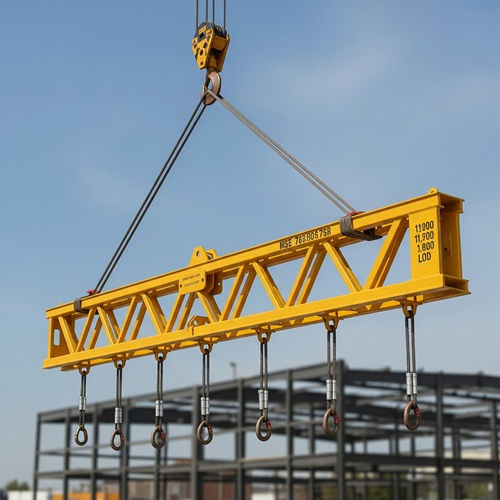Why Spreader Beams Are Essential for Safe Rigging in Construction
- Crane Depot

- Aug 25
- 2 min read

In the world of construction, safety is a top priority—especially when lifting and rigging heavy loads. One critical tool that helps ensure lifting operations are carried out safely and efficiently is the spreader beam. These simple yet powerful devices play an essential role in load distribution and stability, making them indispensable on modern construction sites.
What Is a Spreader Beam?
A spreader beam is a type of lifting device used in conjunction with cranes or hoists. It consists of a horizontal beam that uses slings, chains, or cables to connect to a load at multiple points. Unlike a lifting beam, which supports the load from a single top attachment, a spreader beam has top rigging that spreads out, helping to evenly distribute the load's weight and reduce bending forces.
Spreader beams are designed to handle compressive forces along the beam and tensile forces in the slings or rigging. This makes them ideal for lifting long, heavy, or delicate loads that could be damaged if lifted improperly.
Key Benefits of Using Spreader Beams
1. Improved Load Stability
One of the most significant advantages of spreader beams is their ability to improve load stability. By maintaining a wider sling angle, spreader beams minimize inward compression on the load. This reduces the risk of load deformation or shifting during the lift, especially when handling large or irregularly shaped items like steel beams, pipes, or concrete panels.
2. Minimized Risk of Damage
Without proper lifting support, heavy loads can bend, crack, or become damaged during a lift. Spreader beams ensure even weight distribution, protecting the structural integrity of the materials being lifted. This is particularly important when dealing with fragile or high-value materials.
3. Enhanced Worker Safety
Safety is the primary concern in any lifting operation. Spreader beams help minimize the chances of load failure, which could result in severe injury or even fatalities. By keeping the load balanced and secure, these beams reduce swing, tilt, and unexpected movement, all of which are potential hazards during a lift.
4. Greater Lifting Flexibility
Spreader beams come in a wide range of sizes and configurations, including adjustable spreader beam, modular, and custom-built options. This flexibility allows construction teams to tackle a variety of lifting challenges with confidence. From lifting wide loads to navigating confined spaces, spreader beams offer versatile lifting solutions.
Common Applications in Construction
Spreader beams are frequently used in construction for:
Lifting precast concrete elements
Installing structural steel sections
Transporting large HVAC units
Handling long pipelines or rebar bundles
Rigging fragile or unusually shaped components
These applications highlight the beam’s role in safe, efficient, and damage-free load handling.
Compliance and Standards
To ensure safety and reliability, spreader beams must comply with relevant industry standards, such as ASME B30.20 and OSHA regulations. Using certified equipment and following proper rigging practices helps companies meet legal requirements and avoid costly accidents or penalties.
Final Thoughts
In construction, every lift comes with risk—but with the right equipment and adherence to safety best practices when using spreader beams, those risks can be effectively managed. Spreader beams are a critical tool for safe rigging, offering load stability, protection, and worker safety. Whether lifting massive steel girders or fragile glass panels, these beams ensure that every lift is performed safely, efficiently, and in compliance with industry best practices.




Comments